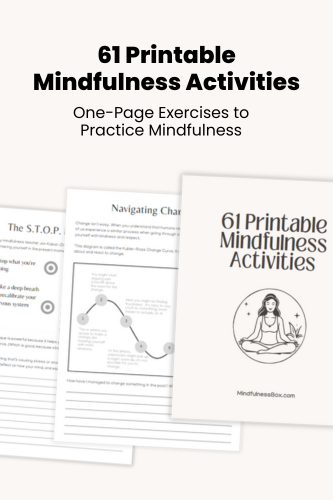Mindlessness isn’t the same as thoughtlessness. Instead, it’s a state of autopilot in which your thoughts have drifted elsewhere—for example, avoiding uncomfortable emotions by watching TV.
Mindlessness. We’ve all been there.
For me, it strikes most often when I’m at my least rested, or perhaps already experiencing a low mood. My mind struggles even more than usual to stay present, and the appeal of mindlessness grows, because if the present moment is uncomfortable—well, maybe letting my thoughts drift isn’t so bad.
Get dozens of one-page exercises to help practice mindfulness, meditation, gratitude, and self love. Perfect for printable handouts when teaching mindfulness to groups, students, or in the workplace.
To see examples, plus a full list of the 61 exercises included, click below.
Of course, mindlessness isn’t a rare occurrence for any of us who aren’t full-time monks. In fact, according to Harvard University, humans spend an average of 46.9% of each day thinking about something they’re not doing.
That is to say, without intervention, you’re likely to spend nearly half of your life outside of the present moment. The goal of mindfulness is to get that number down, so you’re present more of the time.
And the best way to get the number down is to understand, first of all, what mindlessness is, and when you’re slipping into it, so you can nudge yourself back to the present.
Mindfulness vs mindlessness
The main difference between mindfulness and mindlessness is that mindfulness is a deliberate choice to focus on the present moment, while mindlessness is a state of autopilot in which you’re not paying attention, and your thoughts have drifted somewhere else.
Mindlessness often hits harder the more settled you get into a certain routine or way of being, and the more repetitive you get in your habits. The mind takes advantage of routines and regular habits and environments to create shortcuts, allowing your brain to go on autopilot and conserve energy.
In the sense of automating a routine habit like driving, mindlessness may be considered positive, as it helps keep you safer and lets you focus your attention on other things. But many instances of mindlessness show up when you’re doing an activity that deserves your close attention, or that you ought to be present for to fully enjoy. Instead, your thoughts drift and you’re not fully there.
Paying attention to the present moment through mindfulness exercises helps to strengthen your muscle of attention and keep you more present, regardless of how steady your habits, routines or environment may be.
7 mindlessness examples
Mindlessness isn’t inherently part of certain activities, and can be present while doing anything. Examples of mindlessness are:
- Rushing somewhere without paying attention to the environment around you
- Reading and having to go back and read the last page again
- Being half present in a conversation while scrolling through your smartphone
- Arriving home and realizing you don’t remember any details about your commute
- Eating dinner quickly without paying attention to the flavors, smells or textures
- Avoiding uncomfortable emotions by drinking alcohol or watching TV
- Riding your bike while thinking about something embarrassing you said
What causes mindlessness?
Mindlessness isn’t caused by a character flaw. It’s actually inherent in human nature.
Human brains are designed to conserve as much energy as possible, which means you tend to develop automatic processes for anything you do frequently, from driving to brushing your teeth to taking the same path on your daily walk.
That’s why it can sometimes feel easier to be mindful and aware of the present moment when you’re exploring a new place, or when you’re immersed in a different culture and language. Everything that’s happening in the present moment is new, and relies on your full attention. You can’t pull from the automatic processes that power your normal daily routine.
You can also find your brain taking shortcuts to evaluate people, which leads to bias. Your brain attempts to conserve energy by lumping people into categories based on others you’ve met in the past, or based on cultural information you’ve absorbed. (Mindfulness can help with this).
Your brain is also wired for distraction. Long stretches of attention towards your own thoughts or on a detailed project wouldn’t have helped your ancestors survive in the wild. Humans evolved to be constantly attuned to threats, which means your brain is constantly interpreting the environment around you for signs of danger.
The instinct to conserve energy, plus the predisposition towards distraction, is a recipe for mindlessness that’s baked into humans from the start.
That’s why mindfulness is a practice—you need to practice, because it doesn’t come naturally.
Why smartphones, TV and video games aren’t inherently “mindless”
Mindlessness happens any time your attention leaves the present moment and drifts to thoughts about the past or the future instead.
That means that while “mindlessness” is often associated with scrolling through social media, watching TV or playing video games, none of those activities are inherently mindless as long as you’re fully present in doing them.
However, perhaps especially in the case of smartphones and social media, it’s easy to use these activities as an escape from the present moment. Effectively, you’re half in one place, half in another. You might even be in three places: paying attention to what you’re supposed to be doing, wishing the situation was different, and paying attention to your phone.
Sometimes, mindlessness is a good thing
Really?
Yes, under some circumstances.
When you’re highly skilled at something—say, golf—you’re relying on dozens or hundreds of automatic processes, from precise muscle memory to the instinct that comes from experience. Thinking too carefully or paying too much attention to each step in the process can be detrimental to the outcome, according to Scientific American.
Instead, when you’re going for that winning putt, it’s probably more advantageous to immerse yourself in the experience as in a state of flow, and rely on your instincts.
Also, for people who have experienced trauma, mindfulness is a useful tool but mindfulness meditation can sometimes trigger trauma, according to Psychology Today. Introspection and allowing any and all thoughts to rise up nonjudgmentally can be challenging in this scenario. Instead, focusing on grounding techniques that help you feel safe as well as bodily movement may be helpful.
Here’s what the experts say
Jon Kabat-Zinn, one of the leading mindfulness experts, said this about mindlessness:
Mindless thinking is “like driving the car with the brake on” while mindfulness encourages one to live a life with more lightness. “It’s about living your life as if it really mattered – bringing mindfulness to times and to relationships. This is as deep as humans can go in terms of self-compassion and self-inquiry.”
Thich Nhat Hanh, who was a Buddhist monk and mindfulness teacher, shared the following comment about mindlessness:
“What happens when we habitually run away from what’s going on inside us and in our relationships, though, is that we end up becoming even more alienated and sad. A lot of TV shows, music and games out there can be quite toxic, watering seeds of craving, fear and violence in us. Yes, life and relationships can be challenging at times; but the more we habitually rely on electronics (just as with drugs, or mindless eating) to numb ourselves to what’s happening, the more our problems will persist and proliferate.”
Mindfulness is the antidote to mindlessness
It’s easy to fall into routines and habits that pull you towards mindlessness, or even make mindlessness your default way of being.
Your brain is designed for mindlessness, in a way. To stay in the present moment in a state of appreciation and curiosity, you’re fighting against a headwind of evolutionary and behavioral forces.
On top of that, we all go through cycles of mindlessness and mindfulness. Sometimes, it takes reaching a point of “too much” mindless living in order to get motivated to make a change.
Mindfulness won’t keep you in the present moment 100% of the time, but with practice, your mindless moments will be fewer and fewer.

My mindfulness practice kicked off in 2016 with a ten-day silent retreat. Since then, I’ve read dozens of books about mindfulness and completed hundreds of hours of meditation. Thinking about what makes humans happy, calm, and peaceful is endlessly fascinating to me.


